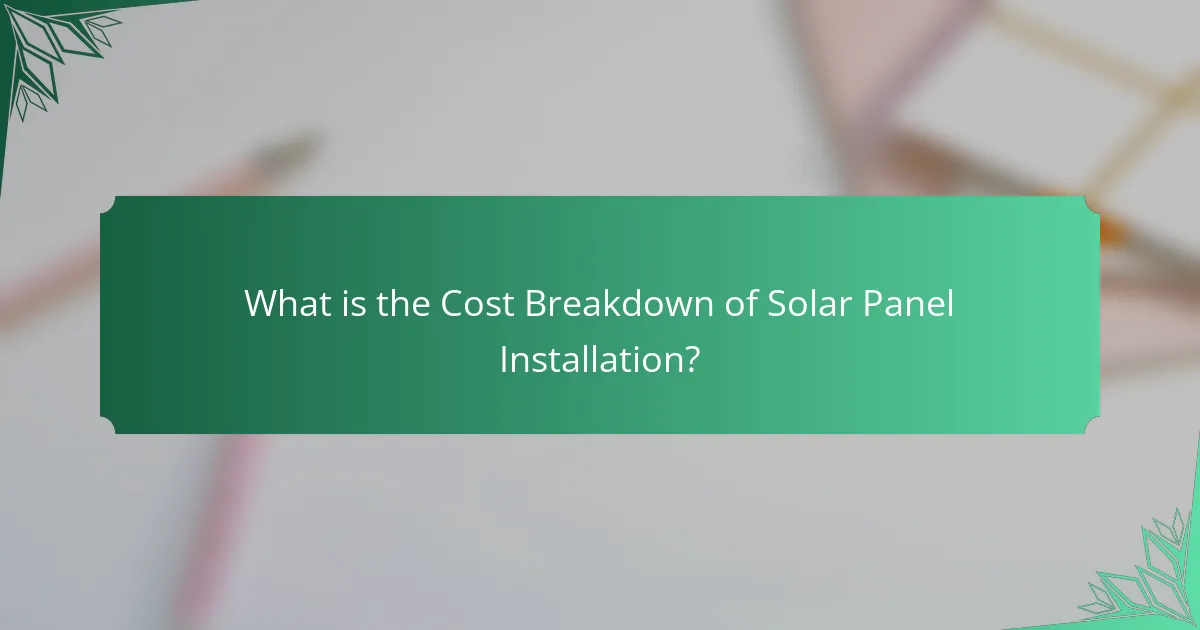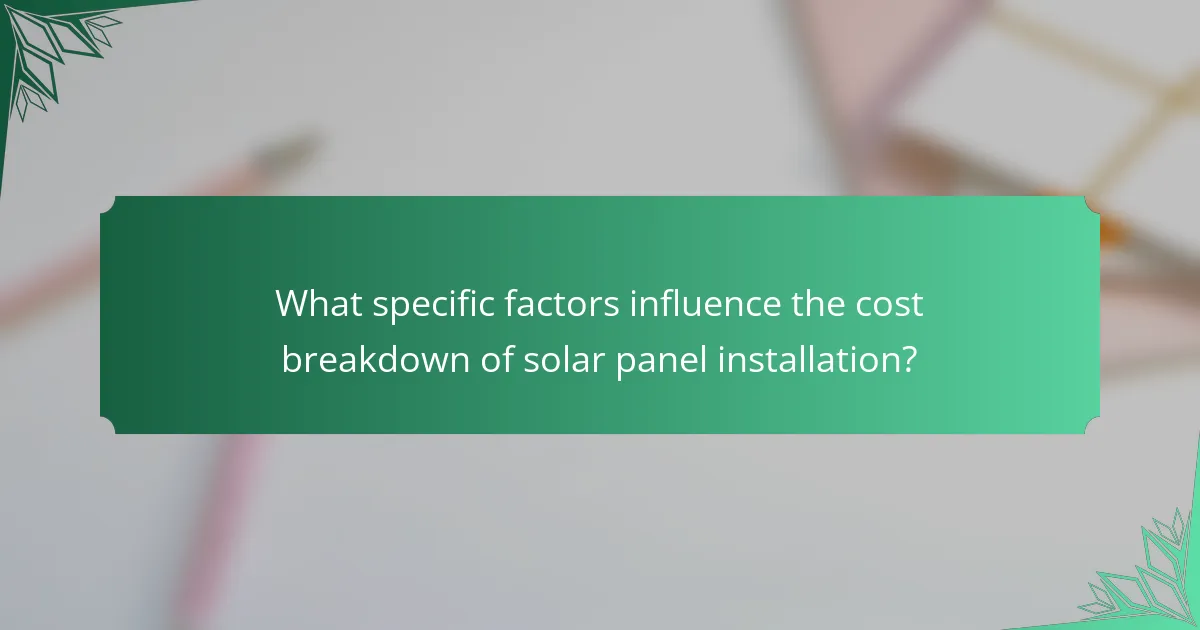
What is the Cost Breakdown of Solar Panel Installation?
The cost breakdown of solar panel installation typically includes equipment, labor, permits, and additional fees. Equipment costs generally account for 50-70% of the total installation price. This includes solar panels, inverters, and mounting hardware. Labor costs usually comprise 10-30% of the total, depending on installation complexity. Permitting fees can vary by location, often ranging from $100 to $1,000. Additional costs may include inspection fees and interconnection fees, which can add another $100 to $500. Overall, the total installation cost averages between $15,000 and $25,000 for a typical residential system. This estimate reflects both the initial investment and the factors that contribute to it.
How is the initial investment for solar panel installation calculated?
The initial investment for solar panel installation is calculated by summing the costs of equipment, installation, and any additional fees. Equipment costs include solar panels, inverters, and mounting hardware. Installation costs cover labor and any necessary permits. Additional fees may involve inspection costs and interconnection fees. The average cost of solar panel installation ranges from $15,000 to $25,000 for a residential system. This figure can vary based on system size and location. Financial incentives, such as tax credits, can reduce the net investment. The federal solar tax credit allows homeowners to deduct a percentage of the installation cost from their federal taxes.
What factors influence the upfront costs of solar panels?
The upfront costs of solar panels are influenced by several key factors. The type of solar panels selected significantly affects the price. Higher efficiency panels typically cost more than standard options. Installation costs also vary based on the complexity of the installation site. Roof type and angle can increase labor time and expense. Local labor rates play a crucial role in determining total installation costs. Additionally, the size of the solar system impacts upfront investment; larger systems generally incur higher costs. Government incentives and rebates can reduce the overall upfront expense. Finally, the quality of materials and equipment used influences the initial investment.
What financing options are available for solar panel installation?
Solar panel installation can be financed through several options. Homeowners can utilize solar loans, which allow them to borrow money specifically for solar projects. These loans often have competitive interest rates and flexible repayment terms. Another option is leasing, where homeowners pay a monthly fee to use the solar system without owning it. Power purchase agreements (PPAs) are similar, allowing homeowners to pay for the power generated by the solar system at a set rate. Additionally, some states offer incentives and rebates that can reduce upfront costs. Federal tax credits, such as the Investment Tax Credit (ITC), can also significantly lower the overall expense. According to the Solar Energy Industries Association, these financing methods make solar more accessible and affordable for many homeowners.
What are the long-term savings associated with solar panel installation?
Long-term savings associated with solar panel installation can be substantial. Homeowners can save between $10,000 to $30,000 over 20 years. This savings comes from reduced electricity bills. Solar panels can lower energy costs by up to 70%. Additionally, many regions offer tax incentives that enhance savings. For instance, the federal solar tax credit allows homeowners to deduct 26% of installation costs from their taxes. Furthermore, solar panels increase property value, often by about 4%. These financial benefits make solar energy a cost-effective long-term investment.
How do solar panels impact electricity bills over time?
Solar panels reduce electricity bills over time by generating renewable energy. Homeowners can offset their energy consumption with solar power. This leads to lower reliance on grid electricity. Many households see a significant decrease in monthly utility costs. According to the U.S. Department of Energy, solar energy can save homeowners between $10,000 to $30,000 over 20 years. Additionally, solar panel systems can increase property value. The savings on electricity bills often cover the initial investment within a few years. Therefore, solar panels provide long-term financial benefits by decreasing monthly expenses.
What incentives and rebates can reduce the overall cost of solar panels?
Federal tax credits can significantly reduce the overall cost of solar panels. The Federal Investment Tax Credit (ITC) allows homeowners to deduct a percentage of the cost of installing a solar energy system from their federal taxes. As of 2023, this percentage is 30%. Many states also offer additional incentives such as rebates, which can further lower upfront costs. For instance, California provides a rebate program through the California Solar Initiative. Local utility companies may also have incentive programs that provide cash rebates for solar installations. These incentives can vary widely by location and availability. Researching local and state programs is essential for maximizing savings on solar panel installation.
What maintenance costs should be considered for solar panel systems?
Maintenance costs for solar panel systems include cleaning, inspections, and repairs. Cleaning is necessary to remove dirt and debris that can reduce efficiency. Inspections ensure that all components are functioning properly. Regular inspections can help identify issues early. Repairs may be needed for damaged panels or inverters. The average cost for cleaning ranges from $100 to $300 annually. Inspection costs can vary but typically range from $150 to $500. Repair costs depend on the extent of the damage and can be significant. Overall, budgeting for these maintenance costs is essential for optimal performance and longevity of solar panel systems.
What routine maintenance is required for solar panels?
Routine maintenance for solar panels includes regular cleaning and inspections. Cleaning removes dirt and debris that can reduce efficiency. Inspections check for any physical damage or loose connections. It’s recommended to clean panels every six months or as needed. Inspections should occur annually or after severe weather events. Monitoring system performance helps identify issues early. Keeping records of maintenance activities ensures consistent care and performance tracking. These practices help maintain optimal energy production and extend the lifespan of the solar system.
How do maintenance costs vary by solar panel type?
Maintenance costs vary by solar panel type due to differences in technology and materials. Monocrystalline panels typically have lower maintenance costs. They are more efficient and durable, requiring less frequent cleaning and upkeep. Polycrystalline panels may incur slightly higher costs due to lower efficiency, leading to more regular maintenance needs. Thin-film solar panels can have the highest maintenance costs. Their materials may degrade faster, necessitating more frequent inspections and repairs. Research indicates that maintenance costs can range from $15 to $25 per panel annually, depending on the type.

How does the initial investment affect the overall financial picture?
The initial investment in solar panel installation significantly impacts the overall financial picture. A higher initial investment typically leads to greater long-term savings. For instance, installing solar panels can reduce electricity bills by 50% to 90%. This reduction translates into substantial savings over the lifespan of the system, often exceeding 20 years. Additionally, federal tax credits and local incentives can offset initial costs, enhancing financial returns. According to the Solar Energy Industries Association, homeowners can save an average of $20,000 over 20 years. Thus, the initial investment is crucial in determining long-term financial benefits.
What is the return on investment (ROI) for solar panel installation?
The return on investment (ROI) for solar panel installation typically ranges from 10% to 30%. This percentage reflects the savings on electricity bills and potential incentives. The average payback period for solar panels is about 5 to 7 years. After this period, homeowners can enjoy free electricity for the remaining lifespan of the system, which is often 25 years or more. According to the U.S. Department of Energy, solar energy can save homeowners thousands over time. Additionally, property values may increase by an average of 4.1% with solar installations.
How is ROI calculated for solar energy systems?
ROI for solar energy systems is calculated by measuring the financial return on the investment in solar panels. The formula for ROI is (Net Profit / Total Investment) x 100. Net Profit is determined by subtracting the total costs of the solar system from the total savings generated over its lifespan. Total Investment includes the initial purchase price, installation costs, and any maintenance expenses.
For example, if a solar system costs $15,000 and saves $1,500 annually on electricity bills, over 20 years, it will save $30,000. Subtracting the initial investment from the total savings gives a net profit of $15,000. Using the ROI formula, the calculation would be ($15,000 / $15,000) x 100, resulting in an ROI of 100%.
This calculation helps homeowners and businesses assess the financial viability of investing in solar energy systems.
What time frame can be expected for recouping the initial investment?
The time frame for recouping the initial investment in solar panel installation typically ranges from 5 to 10 years. This period depends on several factors, including system cost, local electricity rates, and available incentives. On average, homeowners can expect a payback period of around 7 years. According to the U.S. Department of Energy, solar panel systems can save homeowners approximately $20,000 to $30,000 over their lifespan. This savings can significantly offset the initial investment, making solar energy a financially viable option in the long run.
What role do energy prices play in long-term savings?
Energy prices significantly influence long-term savings for consumers. Higher energy prices lead to increased costs for electricity, which can drive individuals to seek alternatives like solar energy. By investing in solar panels, consumers can reduce their reliance on grid electricity, thus mitigating the impact of rising energy prices.
Studies indicate that homeowners with solar installations can save thousands over the life of their systems. For example, the National Renewable Energy Laboratory (NREL) found that solar can reduce electricity bills by 50-90% depending on system size and local energy rates. As energy prices continue to rise, the financial benefits of solar energy become more pronounced, enhancing long-term savings.
How do fluctuating energy prices affect solar panel savings?
Fluctuating energy prices significantly impact solar panel savings. When energy prices rise, the savings from solar panels increase. Homeowners offset higher electricity costs by generating their own power. Conversely, if energy prices drop, the savings from solar panels may decrease. This is because the incentive to switch to solar diminishes when grid electricity is cheaper. According to the U.S. Energy Information Administration, residential electricity prices have varied, with a notable increase of 5% in recent years. This trend supports the economic advantage of solar energy during periods of rising prices. Overall, solar panel savings are directly correlated with the volatility of energy prices.
What predictions exist for future energy prices and their impact on solar investments?
Future energy prices are predicted to rise due to increasing demand and limited supply. Analysts forecast a significant upward trend in electricity costs over the next decade. This anticipated increase in energy prices enhances the appeal of solar investments. Higher energy prices make solar power more economically viable for homeowners and businesses. As electricity rates climb, the return on investment for solar systems improves. Furthermore, government incentives and decreasing solar installation costs support this trend. Studies indicate that as energy prices rise, solar adoption rates also increase. These factors collectively suggest a positive outlook for solar investments in the context of rising energy prices.

What specific factors influence the cost breakdown of solar panel installation?
The specific factors influencing the cost breakdown of solar panel installation include equipment costs, labor expenses, and permitting fees. Equipment costs encompass the price of solar panels, inverters, and mounting systems. Labor expenses are associated with the installation process, including technician wages. Permitting fees are required for legal compliance and vary by location. Additional factors include system size, type of solar technology, and installation complexity. For instance, larger systems typically incur higher costs but may offer better economies of scale. Local incentives and rebates can also significantly reduce overall expenses. According to the Solar Energy Industries Association, the average cost of solar installations has decreased by over 70% since 2010, reflecting advancements in technology and increased competition.
How do location and installation conditions affect costs?
Location and installation conditions significantly affect costs. Geographic location influences solar panel efficiency and energy production. Areas with high sunlight exposure reduce the payback period and overall costs. Installation conditions, such as roof type and angle, impact labor and materials needed. Complex installations may require additional equipment, increasing expenses. Local regulations and permitting can also add to costs. For instance, urban areas may have higher labor rates than rural locations. According to the Solar Energy Industries Association, installation costs can vary by over 30% depending on these factors.
What geographical factors can increase or decrease installation costs?
Geographical factors significantly influence installation costs of solar panels. Proximity to suppliers and installers can lower transportation expenses. Urban areas often have higher labor costs compared to rural locations. Local incentives and rebates can reduce overall expenses in certain regions. Weather conditions impact installation efficiency and material durability. Regions with high solar irradiance may require fewer panels, lowering costs. Local regulations and permitting processes can either expedite or delay installations, affecting costs. Accessibility of the installation site can also increase or decrease labor and equipment costs. These factors collectively determine the final installation price.
How do roof type and orientation impact the installation process?
Roof type and orientation significantly impact the solar panel installation process. Different roof types, such as flat, pitched, or gabled, require specific mounting systems and installation techniques. A flat roof may need ballasted mounting, while pitched roofs typically use anchored mounts. Orientation affects the sunlight exposure that solar panels receive. South-facing roofs generally provide optimal energy production due to maximum sun exposure. Conversely, east or west-facing roofs may produce less energy but can still be effective. According to the National Renewable Energy Laboratory, the angle and direction of the roof can influence energy output by up to 25%. Therefore, understanding roof type and orientation is crucial for efficient solar panel installation.
What are the common misconceptions about solar panel costs?
Common misconceptions about solar panel costs include the belief that they are prohibitively expensive. In reality, the cost of solar panels has decreased significantly over the past decade. According to the U.S. Department of Energy, the price of solar photovoltaic systems dropped by nearly 90% since 2009. Another misconception is that solar panels require a large upfront investment without considering long-term savings. Many homeowners can recoup their initial costs through energy savings and tax incentives. Additionally, some believe that solar panels only work in sunny climates. However, solar technology can generate energy in various weather conditions. Understanding these misconceptions can lead to more informed decisions about solar energy investments.
Why do some people believe solar panels are too expensive?
Some people believe solar panels are too expensive due to high initial installation costs. The average cost of solar panel installation can range from $15,000 to $25,000 for residential systems. This upfront investment can deter potential buyers. Additionally, some individuals may not be aware of available incentives or rebates that can reduce these costs. The perception of high prices is often influenced by a lack of understanding of long-term savings. Over time, solar panels can significantly lower electricity bills. Studies show that homeowners can save between $10,000 to $30,000 over 20 years. Despite these savings, the initial financial barrier remains a key concern for many.
What are the myths surrounding solar panel maintenance costs?
Myth: Solar panel maintenance costs are prohibitively high. In reality, maintenance costs are typically low. Most solar panels require minimal upkeep, often just periodic cleaning. Myth: Solar panels need frequent repairs. Most systems operate reliably for 25 years or more with few issues. Myth: All solar panel systems require professional maintenance. Many homeowners can perform basic maintenance themselves. Myth: Maintenance costs will negate savings from solar energy. Studies show that long-term savings usually outweigh maintenance expenses.
What tips can help minimize costs during solar panel installation?
To minimize costs during solar panel installation, consider obtaining multiple quotes from different installers. Comparing prices helps identify competitive rates. Research available local and federal incentives to reduce the overall expense. Utilizing tax credits can significantly lower installation costs. Opting for a smaller system that meets your energy needs can also save money. Installing during off-peak seasons may lead to lower labor costs. Additionally, choosing high-efficiency panels can maximize energy output, providing better long-term savings. Finally, consider DIY options for certain installation aspects, but ensure compliance with local regulations.
The main entity of this article is the cost breakdown of solar panel installation. It provides a detailed analysis of the initial investment required, which includes equipment, labor, permits, and additional fees, averaging between $15,000 and $25,000 for residential systems. The article also explores factors influencing upfront costs, financing options, long-term savings, and maintenance expenses associated with solar panel systems. Key insights include the impact of energy prices on savings, available incentives, and common misconceptions regarding costs and maintenance, offering a comprehensive overview for homeowners considering solar energy investments.